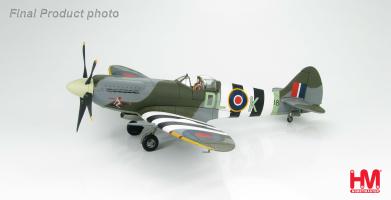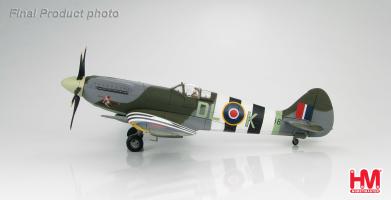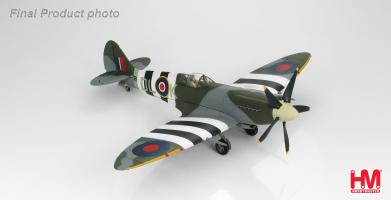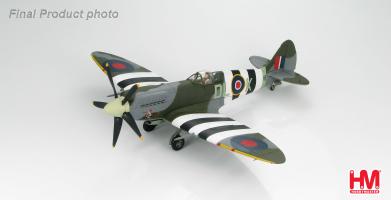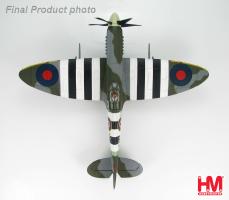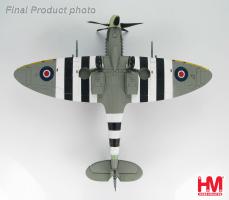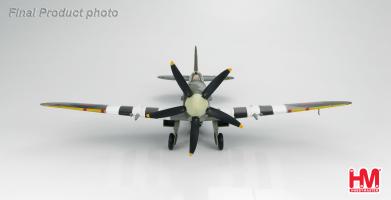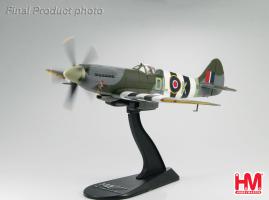Hobby Master Archive
Air Power Propellers 1/48
Spitfire
Spitfire XIV RB188/DL-K Flt. Lt. H D Johnson, No. 91 Sqn., West Malling, July 1944
Hobby Master 1/48 Air Power Series HA7109 Spitfire XIV “RB188/DL-K” Flt. Lt. H D Johnson, No. 91 Sqn., West Malling, July 1944
1/48 scale pre-finished Die-cast metal with a minimum of plastic. Professionally painted. All markings pad applied for superb results. Cockpit slides open. Cockpit side door opens. Comes with a pilot that can be removed. Comes with display stand. Landing gear is fully retractable and can be displayed up or down. Removable wing gun covers. Propeller is metal. Extremely sought after by collectors.
Spitfire XIV specifications Basic information: Country of origin: Britain Classification: single-engine fighter Crew: 1 Production: first produced in 1943 Number produced: 957 of all XIV variants Dimensions: Wingspan: 36ft 10in (11.23m) Length: 32ft 8in (9.96m)
Performance: Powerplant: 1 X Rolls-Royce Griffon 65 12 cylinder liquid-cooled engine 2,035hp (1,517kW) Speed max: 447mph (720km/h) Range: 460 miles (740 km) on internal tanks Ceiling max: 42,978ft (13,100m)
Weight: Empty: 6,603lb (2,995kg) Maximum: 10,285lb (4,665kg)
Armament: 2 X 20mm (.078in) Hispano cannons 4 X Browning 7.7mm (0.303in) machine guns Up to a 1,000lb (454kg) payload with other options possible
Probably one of the best-known fighters of WWII the Spitfire had a big psychological effect at home and in Germany. With its great performance the British were given hope of surviving the Battle of Britain and the German pilots learned to respect its fighting capabilities. The name Spitfire came from a nickname the director of Vickers-Armstrongs had for his spirited daughter. There were 24 marks of the Spitfire and many sub-variants. The Mk. XIV was only an interim variant until the Mk. XVIII could be produced. The Spitfire was the only Allied aircraft in continuous production throughout WWII with 957 Mk. XIVs being produced. The Mk. XIV received several modifications such as a bubble canopy and a modified rear fuselage.
The RAF code-name for the V1 rocket was “Diver”. With a total of 13.5 Divers destroyed by him, No. 91 (Nigeria) Squadron pilot Flt. Lt. H D “Johnny” Johnson was one of the most successful V1 Spitfire pilots. This Johnson isn’t to be confused with James Edgar “Johnnie” Johnson. H. D.’s first victory was shared on June 23, 1944. The nose art on this Spitfire XIV RB188/DL-K displayed a very colorful drawing of a nude red-headed woman named BRÜMHILDE riding a V1. RB188/DL-K was also used to add to the total victories of ace Flt. Lt. Ken Collier and ace Flt. Lt. Jean Maridor. Later this aircraft served with 130 and 350 Squadrons on the Continent and post war was transferred to Thailand.
“Nigeria” Squadron 91 Nigeria paid for 20 presentation aircraft that equipped the No. 91 Squadron. Painted just forward of the cockpit each aircraft had the name “Nigeria” followed by the name of a specific province.
| Added to archive | 2015-11-19 |
| Last modified | 2015-11-19 |
| Leaflet | 2011-02-01 February 2011 |

